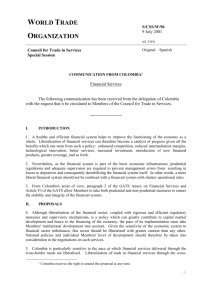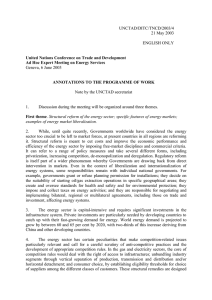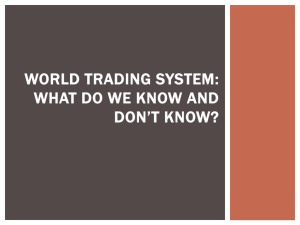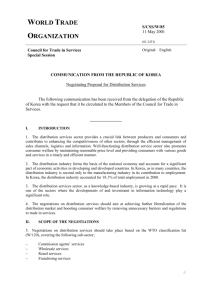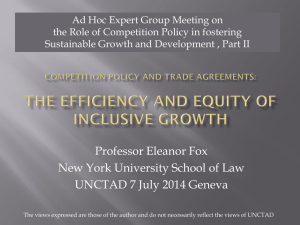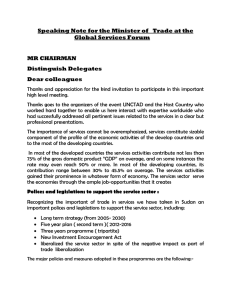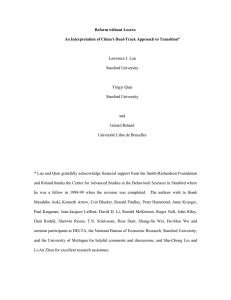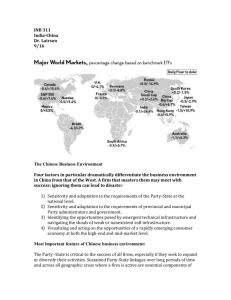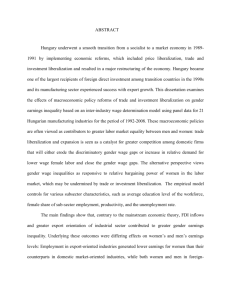Trade Note Services in a Development Round September 10, 2003
advertisement
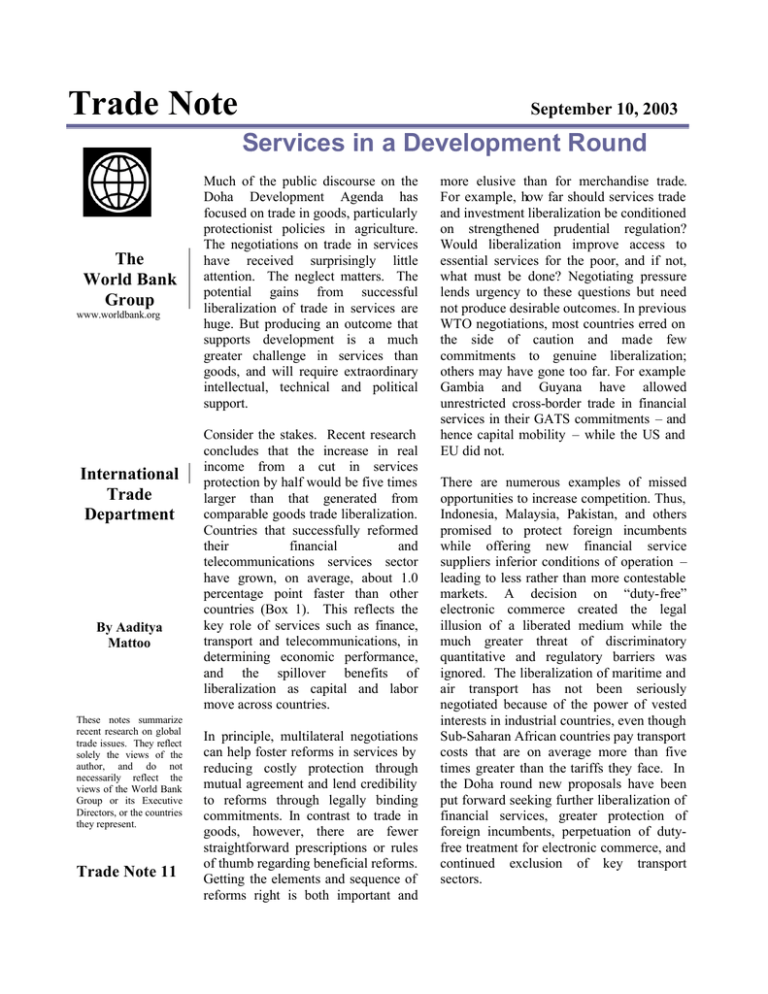
Trade Note September 10, 2003 Services in a Development Round The World Bank Group www.worldbank.org International Trade Department By Aaditya Mattoo These notes summarize recent research on global trade issues. They reflect solely the views of the author, and do not necessarily reflect the views of the World Bank Group or its Executive Directors, or the countries they represent. Trade Note 11 Much of the public discourse on the Doha Development Agenda has focused on trade in goods, particularly protectionist policies in agriculture. The negotiations on trade in services have received surprisingly little attention. The neglect matters. The potential gains from successful liberalization of trade in services are huge. But producing an outcome that supports development is a much greater challenge in services than goods, and will require extraordinary intellectual, technical and political support. Consider the stakes. Recent research concludes that the increase in real income from a cut in services protection by half would be five times larger than that generated from comparable goods trade liberalization. Countries that successfully reformed their financial and telecommunications services sector have grown, on average, about 1.0 percentage point faster than other countries (Box 1). This reflects the key role of services such as finance, transport and telecommunications, in determining economic performance, and the spillover benefits of liberalization as capital and labor move across countries. In principle, multilateral negotiations can help foster reforms in services by reducing costly protection through mutual agreement and lend credibility to reforms through legally binding commitments. In contrast to trade in goods, however, there are fewer straightforward prescriptions or rules of thumb regarding beneficial reforms. Getting the elements and sequence of reforms right is both important and more elusive than for merchandise trade. For example, how far should services trade and investment liberalization be conditioned on strengthened prudential regulation? Would liberalization improve access to essential services for the poor, and if not, what must be done? Negotiating pressure lends urgency to these questions but need not produce desirable outcomes. In previous WTO negotiations, most countries erred on the side of caution and made few commitments to genuine liberalization; others may have gone too far. For example Gambia and Guyana have allowed unrestricted cross-border trade in financial services in their GATS commitments – and hence capital mobility – while the US and EU did not. There are numerous examples of missed opportunities to increase competition. Thus, Indonesia, Malaysia, Pakistan, and others promised to protect foreign incumbents while offering new financial service suppliers inferior conditions of operation – leading to less rather than more contestable markets. A decision on “duty-free” electronic commerce created the legal illusion of a liberated medium while the much greater threat of discriminatory quantitative and regulatory barriers was ignored. The liberalization of maritime and air transport has not been seriously negotiated because of the power of vested interests in industrial countries, even though Sub-Saharan African countries pay transport costs that are on average more than five times greater than the tariffs they face. In the Doha round new proposals have been put forward seeking further liberalization of financial services, greater protection of foreign incumbents, perpetuation of dutyfree treatment for electronic commerce, and continued exclusion of key transport sectors. TRADE NOTE September 4, 2003 Box 1: Dynamic benefits of services trade reform Certain services industries clearly possess growth-generating characteristics. Thus, financial services play a central role in the transformation of savings to investment, telecommunications in the diffusion of knowledge, transport in a country’s ability to participate in global trade, education and health services in building up the stock of human capital, and business services in reducing transactions costs and adding value to products. Barriers to entry in a number of services sectors, ranging from telecommunications to professional services, often are maintained not only against foreign suppliers but also against new domestic suppliers. Full liberalization can, therefore, lead to enhanced competition from both domestic and foreign suppliers. Greater foreign factor participation and increased competition together imply a larger scale of activity, and hence greater scope for generating the growth-enhancing effects. Even without scale effects, the import of foreign factors that characterizes Figure 1: Services liberalization indices: Telecoms and financial services sector liberalization could still have positive effects because services they are likely to bring technology with them. South Asia (3) Econometric evidence suggests that openness in services influences long run growth performance (see Figure 1). After controlling for other determinants of growth, countries that fully reformed the financial services sector grew, on average, about 1.0 percentage point faster than other countries [during what period?]. An even greater impetus on growth was found to come from fully reforming 1 both the telecommunications and the financial services sectors. Estimates suggest countries that fully liberalized both sectors grew, on average, about 1.5 percentage points faster than other countries. EAP (5) Financial Services SSA/MNA (17) ECA (3) LAC (18) High Income (26) SSA/MNA (42) ECA (3) South Asia (5) Telecoms EAP (8) LAC (21) High Income (21) 0 2 4 6 8 10 Source:Mattoo, Rathindran & Subramanian. (2001). 1 Greater liberalization in services is associated with more rapid growth Linear prediction GUY .059 DNK Growth rate (controlling for other factors) While these estimates indicate that there are substantial gains from liberalizing key services sectors, it would be wrong to infer that these gains can be realized by a mechanical opening up of services markets. Badly designed reform programs can substantially undercut the benefits of liberalization. For example, if privatization of state monopolies is conducted without concern to creating conditions of competition, the result may be merely transfers of monopoly rents to private, perhaps foreign, owners. Similarly, if increased entry into financial sectors is not accompanied by adequate prudential supervision and full competition, the result may be insider lending and poor investment decisions. Also, if policies to ensure universal service are not put in place, liberalization need not improve access to essential services for the poor. Managing reforms of services markets therefore require that trade opening be accompanied with a careful combination of competition and regulation. SWE SLV GBR NOR USA ISL NIC BRA IND CRI DOM SGP ARG PAN CHL MLT MOZ COL THA URY PER KEN HND MWI VEN CAN BEL FRA AUT FIN ESP AUS ITA NLD EGY BOL KOR PRT LKA TUN MAR TUR CYP MYS ZAF GRC JAM PHL MEX NZL CHE ECU IDN -.024 AGO 1 Composite services liberalization index 8.5 Source: Mattoo, Rathindran and Subramanian (2001) The measure of reform included not just liberalization but also regulatory improvements. 2 TRADE NOTE At Cancun, services are unlikely to be an area of disagreement. The Draft Ministerial Text suggests that Ministers will recognize the progress made in the negotiations and urge participants to intensify efforts to reach a successful conclusion. The progress so far consists of a large number of confidential but reportedly highly ambitious requests that Members (including a number of developing countries) have made to each other for greater market access, and reportedly disappointing offers of improved access submitted so far by thirty or so Members (including a number of developing countries). Negotiations on completing the GATS framework of rules (on safeguards, government procurement, subsidies and domestic regulation) – underway since the conclusion of the Uruguay Round – have also borne little fruit. Developing country engagement in the negotiations has been inhibited by the perception that the “assessment” of trade in services – mandated by the GATS as a condition for the new round of negotiations – has not been adequately carried out; that their domestic regulatory institutions are ill-equipped to deal with the demands of a liberalized market; and that there is little prospect of meaningful liberalization in areas in which they have an export interest. As we look ahead, three types of initiatives are vital for multilateral services negotiations to support development: • the mobilization of intellectual resources to identify the elements of successful reform, • technical and financial assistance to improve the regulatory environment, and • political support to deliver improved market access. No country can participate meaningfully in international services negotiations without understanding how domestic reform is best implemented. This requires careful analysis—the experience with electricity in California and rail transport in Britain suggests there is scope for learning in all countries. Genuine ownership and understanding of reform strategies can only come through active engagement by national stakeholders informed by independent research. This takes time; in many cases, much more time September 4, 2003 than has been allocated for the Doha round. It is important that the commitments countries make reflect good economic policy rather than the dictates of domestic political economy or international negotiating pressure. In the short run, a stock-taking exercise to consider national and cross-country experience with services reform could do much to identify the areas where there is little reason to defer market-opening and those where there is significant uncertainty and a consequent need to temper negotiating demands. Sound domestic regulation – ranging from prudential regulation in financial services to procompetitive regulation in a variety of networkbased services –will be critical to realizing the benefits of services liberalization. Regulatory institutions can be costly and require sophisticated skills. For example, even a bare-bones telecommunications regulatory authority is likely to cost around $2 million each year, or 5 per cent of government budget in a country like Dominica. A number of non-governmental organizations have drawn valuable attention to the impact of services liberalization on the poor. The problem here is not so much what the WTO (GATS) forces countries to do or what it prevents them from doing, but what the GATS does not – indeed cannot – ensure: complementary action by national governments to help the poor benefit from liberalization. The denial or inadequate recognition of this problem can lead to social costs and erode support for reform. In recent years a better –though still inadequate – understanding has emerged of the universal access policies that must complement market-based reforms. From telecommunications in Chile, Peru and India, to electricity in Guatemala, variations on a basic idea have been implemented: private providers competing for subsidies that are granted on the basis of how they perform in supplying services to the poor. But while the more advanced developing countries have the institutions, resources and skills to implement these policies, others need support. Such support needs to be based on a country-specific diagnosis of regulatory requirements and assessments of the needs for assistance. Some such work is already underway, for example, as part of the IMF and World Bank Financial Sector Assessment Programs. 3 TRADE NOTE September 4, 2003 Finally, developing countries have a strong interest in securing access to foreign services markets. Cross-border trade in a variety of business services is flourishing with several developing countries among the most dynamic exporters (Box 2). The global benefits of such trade are huge: the United States banking industry alone is estimated to have saved over $8 billion over the last four years, and the cost savings for the world’s top hundred financial institutions could be as high as $138 billion annually. But such trade will also create adjustment pressures and could provoke a protectionist backlash – signs of which are already visible in recent procurement restrictions and regulatory impediments. The question is whether this coincidence of interest can be harnessed to deliver greater openness. Two ambitious proposals are worth considering. First, all WTO Members could agree to lock-in the current openness of cross-border trade in services – by making full commitments on market access and national treatment under the GATS – while recognizing that commitments in no way deprive Members of the right to regulate. Second, Members could agree to liberalize the temporary (say, at most one year) movement of service providers above a specified skill threshold, to fulfill specific services contracts and as intra-corporate transferees. Greater freedom for the temporary movement of service providers - notionally incorporated in the GATS but still highly restricted - would enable developing countries to provide the labor component of construction, distribution, transport and a range of other services. Supplying such services through temporary movement potentially offers a way to realize the gains from trade while averting social and political costs in host countries, as well as brain drain type of negative effects for poor home countries. Recent research finds that if OECD countries were to allow temporary access to foreign service providers equal to just 3 per cent of their labor force, the gains to all countries would be over $150 billion – more than the gains from the complete liberalization of all trade in goods. There is considerable scope for the WTO to play its traditional role of facilitating reciprocal liberalization, not only by exploiting trade-offs across goods and services but also within services. Utilizing this scope would make the GATS a real force for additional reform. But for the process to work, the services industries that stand to gain in high-income countries—those who would sell financial, telecommunications and other services in developing countries—must make a greater effort to counter protectionism at home in areas of developing country export interest as well as to meet their needs for technical assistance. Only then will we witness a virtuous cycle of mutually beneficial liberalization rather than a bitter round of grudging concessions. 4 TRADE NOTE September 4, 2003 Box 2: Growing Stake of Developing Countries in Cross Border Trade in Business Services The IMF Balance of Payments category “other business services” (i.e. other than services like banking, insurance and telecommunication) includes a range of services that provide intermediate inputs throughout the production process (for both goods and services). As the figure below shows, the bulk of such exports still originate in OECD countries. But the exports of the European Union and the United States have grown by respectively 3.5 and 11.2 per cent per annum in the second half of the 1990s, the exports of countries like India, Peru, Israel, Romania and Brazil have grown at rates above 30 per cent per annum. Moreover, many other developing countries – including Nicaragua, Argentina, Jamaica, China and Barbados – have witnessed high rates of growth. Regional Distribution of Other Business Services Exports (billion US dollars) 300 250 1990 1995 200 150 2000 2001 100 50 0 Africa and the Middle East South Asia LAC East Asia and the Pacific OECD Average Growth Rate of Exports of Other Business Services for selected countries, during 1995-2000 India 44.6% 35.4% Peru Note: “Other business services” includes: “merchanting and other trade related services”, “operational leasing services”, and “miscellaneous, business, professional and technical services”. “Miscellaneous, business, professional and technical services” include: “legal, accounting management, consulting, public relations services”, “advertising, market research, public opinion poll services”, “research and development services”, “architectural, engineering, other technical services”, “agricultural, mining, on-site processing services”, “other services” and “services between affiliated enterprises”. 31.7% Israel 31.6% Romania Brazil 30.5% Estonia 28.2% Nicaragua 26.8% Argentina 25.5% 23.4% Jamaica 21.3% Dominica 19.6% China 13.5% Barbados Nigeria 13.5% 12.1% Australia Canada 12.1% United States 11.2% Mauritius -5.6% 10.8% Ghana 4.2% Europe 3.5% Japan Further Reading Global Economic Prospects 2002: Making Trade Work for the World’s Poor. Chapter 3 “Trade in Services: Using Openness to Grow” by Aaditya Mattoo. Mattoo, Aaditya, and Sacha Wunsch. 2003. “Securing Openness of Cross-Border Trade in Services: A Possible Approach”. World Bank. This Trade Note was written by Aaditya Mattoo, Lead Economist in the Development Research Group. . The views expressed in this paper are personal and should not be attributed to the World Bank. This Trade Note can be downloaded at http://www.worldbank.org/trade. For recent research on trade in services, on which this note draws, see http://www.worldbank.org/trade/services 5
